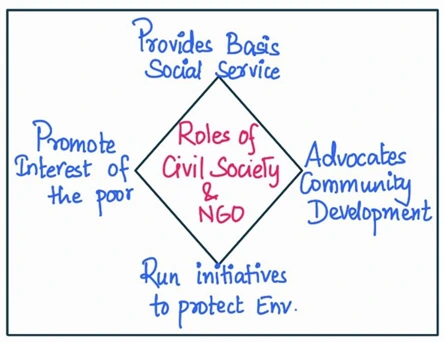Answer:
| Approach:
Introduction
- Introduce the potential role of Civil Society and NGOs in public service delivery as an alternative model, while acknowledging the challenges they face.
Body
- Discuss the potential of NGOs and Civil Society in public service delivery.
- Challenges of the alternative model.
Conclusion
- Write a relevant conclusion.
|
Introduction:
Civil Society Organizations (CSOs) and Non-Governmental Organizations (NGOs) play a pivotal role in India’s socio-economic landscape. They supplement and complement government efforts across various sectors, bridging gaps in public service delivery with innovative, grassroots-based solutions. As per a 2019 report by the Ministry of Statistics and Programme Implementation, India houses approximately 3.2 million NGOs, outnumbering schools and health centers, underlining their significant role.

Body:
Potential of NGOs and Civil Society in public service delivery:
- Targeting marginalized communities:
- NGOs and Civil Society can effectively reach out to marginalized and remote communities, providing them with essential services that may not be adequately covered by government programs.
- The NGO Goonj, through its “Cloth for Work” initiative, has reached remote and marginalized communities, providing them with clothing and other essential items in exchange for community work.
- Innovation and flexibility:
- These organizations can introduce innovative and flexible solutions to address local needs, allowing for more effective and efficient public service delivery.
- Barefoot College trains rural women, often illiterate, to become solar engineers, addressing the lack of electricity in their villages through a unique and flexible approach.
- Participatory approach:
- NGOs and Civil Society can involve local communities in the decision-making process, ensuring that public services are tailored to their specific needs and preferences.
- The NGO Pratham employs a participatory approach by involving communities in its educational programs, ensuring that they are tailored to local needs and preferences.
- Advocacy and awareness:
- These organizations can raise awareness about various social issues and advocate for policy changes, influencing the overall public service delivery landscape.
- The Self Employed Women’s Association (SEWA) raises awareness about women workers’ rights in the informal sector, advocating for policy changes that benefit this often-neglected segment of the population.
Challenges of the alternative model:
- Limited resources: Smile Foundation, despite its wide-ranging initiatives in health, education, and livelihood, faces resource constraints that limit its ability to scale up operations and provide comprehensive services.
- Sustainability: Many NGOs, such as Akshaya Patra, depend on donor funding to sustain their mid-day meal programs, which could impact long-term sustainability if funding sources dwindle.
- Accountability and transparency: In 2015, the Indian government deregistered more than 9,000 NGOs due to non-compliance with regulatory norms, reflecting accountability and transparency concerns.
- Coordination with government agencies: The lack of coordination between government and NGOs in disaster management during the 2013 Uttarakhand floods led to duplication of efforts and inefficiencies in relief operations.
- Political interference: The NGO Greenpeace India faced political interference in 2015 when the government suspended its license, alleging the organization was working against the country’s economic interests.
Conclusion:
By overcoming these challenges, NGOs and Civil Society can play a vital role in complementing government efforts and ensuring efficient public service delivery to the citizens.
